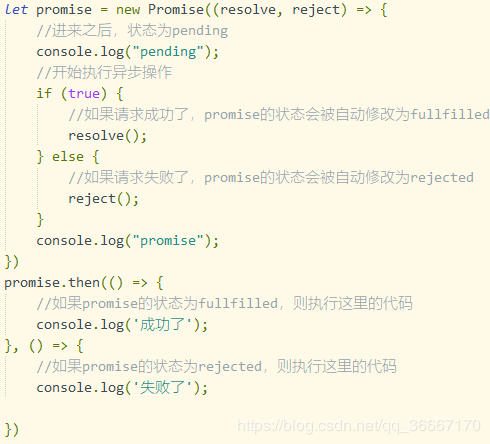
promise
为什么需要promise
需求
通过ajax请求id,再根据id请求用户名,再根据用户名获取email
<!DOCTYPE html>
<html lang="en">
<head>
<meta charset="UTF-8">
<meta http-equiv="X-UA-***patible" content="IE=edge">
<meta name="viewport" content="width=device-width, initial-scale=1.0">
<title>Document</title>
<script src="./jquery-3.6.0.js">javascript"></script>
</head>
<body>
<script>
//通过ajax请求拿到用户id
$.ajax({
type:"GET",
url:"./data1.json",
su***ess:function(res){
let {id} = res;
console.log(id);
//通过用户id找到用户名
$.ajax({
type:"get",
url:'./data2.json',
data:{id},
su***ess:function(res){
let {username} = res;
console.log(username);
//通过用户名找到用户邮箱
$.ajax({
type:"GET",
url:"./data3.json",
data:{username},
su***ess:function(res){
let {email} = res;
console.log(email);
}
})
}
})
}
})
</script>
</body>
</html>
回调地狱
在回调函数中嵌套回调
在上述代码中通过不断请求数据,代码逐级向外递归,形成了回调地狱。
使用promise就可以完美解决,并且让我们的代码更加美观。
Promise的基本使用
Promise是一个构造函数,通过new关键字实例化对象.
语法:
new promise((reso1ve,reject)=>{})
Promise接受一个函数作为参数
在参数函数中接受两个参数
- resolve:
- reject:
promise实例
promise实例有两个属性:
- state:状态
- result:结果
promise的状态
- pending(准备,待解决,进行中)
- fulfilled(已完成,成功)
- rejected(已拒绝,失败)
promise状态的改变
通过调用resolve和reject改变当前promise对象的状态。
- 改为fulfilled
let p = new Promise((resolve,reject)=>{
resolve(); //调用resolve将状态改为fulfilled
});
console.log(p)
- 改为rejected
let p = new Promise((resolve,reject)=>{
reject();//调用reject将状态改为rejected
});
console.log(p)
注意:promise状态的改变是一次性的,即不能同时调用resolve和reject,若同时调用则状态只改变一次。
promise的结果
promise的结果是通过传递resolve/reject的参数来获得的
let p = new Promise((resolve,reject)=>{
resolve("成功")
})
console.log(p);
同理,reject也是如此:
promise方法
then方法
then方法中有两个参数,且都为函数作为参数。
如:
let p = new Promise((resolve,reject)=>{
resolve("成功")
})
p.then(()=>{
console.log('成功时执行');
},()=>{
console.log("失败时执行");
})
console.log(p);
- 第一个函数参数
当promise的状态为fulfilled时,执行该函数 - 第二个函数参数
当promise的状态为rejected时,执行该函数
通过then方法获取promise的结果
通过then方法中的函数传递形参即可获得promise的结果;
let p = new Promise((resolve,reject)=>{
resolve("成功")
})
p.then((value)=>{
console.log('成功时执行',value);
},(reason)=>{
console.log("失败时执行",reason);
})
console.log(p);
总结:promise的状态用来判断then方法执行成功或是失败的函数,promise的结果则是作为实参传递给then方法的函数参数的形参。
then方法的返回值
then方法返回的为一个新的promise对象。且该promise对象的状态为pending,then方法为一个同步操作,then中的函数参数为异步操作。
如上图我们就可以看到then方法的返回值仍然为一个promise对象,且在刚生成该对象时的状态为pending。
由此衍生出了链式操作:
new Promise(()=>{}).then().then()
在该操作中,如果promise对象的状态不改变则不会执行then方法中的函数。那么在then方法返回的promise对象中如何让其状态改变呢??
- 使用return可以将then方法返回的promise对象状态改为fulfilled。
- 在then方法中书写错误代码,即可将其promise对象状态改为rejected
实例:
let p = new Promise((res,rej)=>{
res('苏凉');
})
let t = p.then((value)=>{
return "name:"+value;
},(reason)=>{
console.log("执行失败!");
})
t.then((value)=>{
console.log(value);
},(reason)=>{
console.log(reason);
})
console.log(t);
catch方法
catch方法在promise对象的状态为rejected时亦或者是输入错误代码时被调用,并返回错误原因。
let p = new Promise((res,rej)=>{
throw newError("出错啦!")
})
p.catch((reason)=>{
console.log(reason);
})
console.log(p);
解决回调地狱
//封装Ajax请求函数
function getAjax(path,data){
return new Promise((resolve,reject)=>{
$.ajax({
type:'get',
url:path,
data:{data},
su***ess:function(res){
resolve(res)
},
error:function(res){
reject(res)
}
})
})
}
getAjax('./data1.json')
.then((value)=>{
let id = {value};
return getAjax("./data2.json",id)
})
.then((value)=>{
let {username} = value;
return getAjax('./data3.json',username)
})
.then((value)=>{
console.log(value);
})

